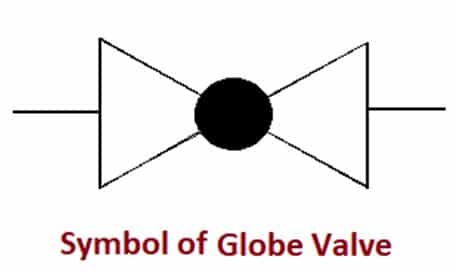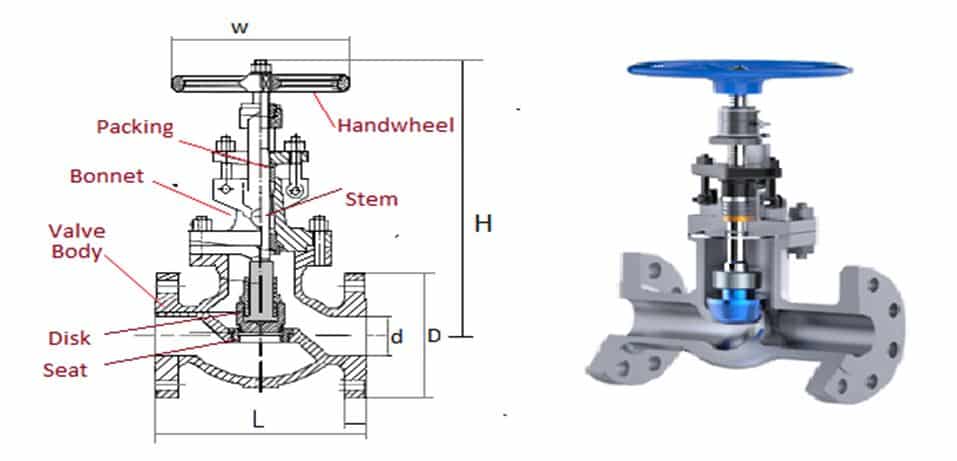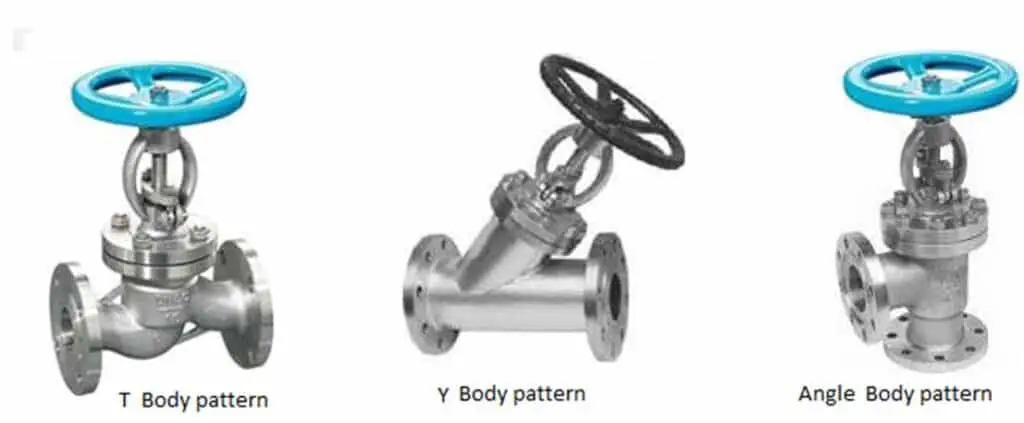Globe valves have a movable disk-type element and a stationary ring seat in a valve body. The valve stem moves a globe plug relative to the valve seat. Globe valves are suitable for on-off services, and it is used for emergency stops & regulating the flow.

Globe valves are linear motion valves and are basically designed to stop and start the flow. The disc of a globe valve can be completely out of the flow path or it can shut off the flow completely. It Provides positive shutoff and frequent operation. Thus, the globe valves are most suitable for those applications where pressure drop across the valve is not a major controlling factor.
Globe Valve Operation
The Globe valve operation is that the disk movement is perpendicular to the seat. As a result, they provide that the space round between the disc and the seat gradually closes as the valve closes.

The property of globe valves a reasonably adequate capacity for regulation. Thus, we can use the globe valves to start and stop the flow and to regulate it.
The main drawbacks related to the use of globe valves are:
1. Higher pressure drop compared to gate valves.
2. Large globe valves require more power or a larger actuator to operate.
Basic Designs of Globe Valve Body

T-body-pattern valve
The T-shaped globe valve design is the most common and widely used body type, with a Z-shaped diaphragm. The horizontal seat adjustment permits the stem and disc to travel perpendicular to the horizontal line. This design has the lowest flow coefficient and the highest pressure drop.
Y-Body Pattern valve
It is an alternative for the fall of high pressures, with an approximate angle of 45 degrees. It offers a straight flow path while fully open, thereby reducing the resistance to flow. Y-type Globe valve has many advantages, such as long service life, easy installation, lower friction when the valve is in operation, maintenance, and lower cost. This type of valve is most suitable for low and medium working pressure working conditions.
Angle-body pattern valve
It is a modification of the basic T-type, with an angle of 90 degrees. Angle body valves economically eliminate the need for separate valves and 90-degree joints. It also saves installation time. Therefore, valves are suitable for pulsating flow applications.
Features of Globe Valve
- These types of valves are suitable where large pressure drops experiences due to process needs.
- Flow regulation of the fluid in these valves changes its direction due to its design. Therefore offering a great resistance to its circulation.
- It is possible to achieve complete closure with these valves. The fluid undergoes a slight deviation in its path inside the valve body and the pressure drops are significant.
- Globe valves are normally characterized by their round-shaped body. It is separated into two halves body separated by a baffle. As a result, this creates an opening that forms the seat in which the disc acts. The disc is connected to a stem that can be threaded (if the valve is manually operated) or slid (if it is automated) to close the valve.
- However, many models of globe valves do not have the traditional ball shape, yet valves that contain the same mechanism are also often referred to as globe valves.
Valve Installation tips
- Always install the valve, so that the pressure is below the disc, except for high–temperature steam service.
- Slightly open the valve to expel the solids adhering to the seat.
- In case of leaks, immediately tighten the packing nut.
Materials of Globe Valve
Globe valves manufacturing materials are cast iron or forged iron & other materials like Bronze (especially works with seawater), carbon steel, stainless steel (petrochemical sector), iron, forged steel, Monel, or brass.
Recommended for Applications
- Globe valve is suitable for shorter stroke lengths as compared to gate valves.
- Available in T, Y, and Angle patterns, each having its individual merits.
- Globe valves are most suitable for throttling or regulation.
- They are for frequent use.
- For effective gas or air shutoff.
- For systems where a certain resistance to flow is acceptable.
- Great regulation capacity.
- Fast actuation response.
- Good throttle with little disc or eat wear.
Disadvantages
- Globe valves experience higher pressure drops as compared to gate valves.
- Requires higher force or larger actuation to seat valve (with pressure under the seat)
- Slow closing
- Considerable pressure drop.
Larger valves would require heavy force on the stem to operate under pressure. Globe valves are available in sizes up to DN 48 inches (DN 1200).
Globe valves actuation mechanism is manual, pneumatic electric, or hydraulic drives.
Typical applications of globe valves
- Cooling water systems where the flow regulation is the criteria.
- High and low drain point ventilation when tightness and safety are important considerations.
- Chemical process (feed lines), feedwater, condenser, and extraction drain systems.
- Boiler traps and drains, main steam traps and drains, and heater drains.
- Turbine seals and drains.
- Lubricating oil system for turbines and others.
Read Next